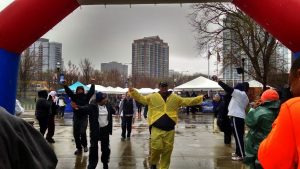Story By Laura Kozak
March 20, 2009 – An imposing wood beam, covered in torn roofing tarp, hangs from the ceiling to the floor. Scattered vertical blinds intertwined with a rumpled bed sheet and other ordinary household items lie nearby. Across from the beam rests a line of cinderblocks, broken and exposed.
It looks like a disaster scene, but that’s the intent.
“A lot of people walk in and then see the piece and are taken aback. They ask ‘Are you open?’ Because it looks like we’re under construction,” said Corinne Rose, education director of the Museum of Contemporary Photography in Chicago.
The site-specific piece, “Debris Field” by Chicago mixed media artist Heather Mekkelson, is part of the MoCP’s current show “PhotoDimensional.”
Mekkelson uses photos of natural disasters from newspapers and the Internet to influence her work, and then recreates the mood of the picture. While the piece may look haphazard, Rose says Mekkelson uses her background as an artist to complete the piece.
Instead of scouring disaster areas for items that she wants to use, she creates them from scratch and then modifies them to appear like they’ve survived the fury of a storm. To make the roofing tarp look authentic, she beat it with old discarded roofing tiles, since that is what would have happened during a storm.
The focus of the exhibit is to “jar our perception of three-dimensional space,” said Rose.
In the show, curator Karen Irvine challenges the idea that photos are “flat.”
In a catalog about the show, Irvine said, “Something is inevitably lost when a three-dimensional sculpture is translated into a two-dimensional photograph. The experience of sharing a space with an object and the experience of seeing that object represented and embedded in another object — a flat photographic print — are very different.”
Looking to explore the relationship between photography and sculpture, the museum has taken a leap in showing several pieces that aren’t traditional photography.
“La Ronde” by German artist Bettina Hoffmann is a 12-mimute video showing four different scenes with 360-degree views of each scene. It is difficult to discern if the video is a compilation of hundreds of photographs or one seamless recording of a very still setting.
Taken at hip level rather than the traditional eye level, the video can be fascinating to some and disorienting to others. Each of the four scenes has a different setting and characters, but a common mood and theme.
“It’s the viewer who completes the story,” said Rose.
Another unusual piece is from Brazilian artist Vic Muniz. Muniz approached the Whitney Museum of American Art in New York and asked if the custodians would collect the dust they swept up off the floor for a few months. Muniz then took the dust and, using the different colors and densities, created drawings based on installation photographs of the museum’s collection.
Muniz recreated Tony Smith’s minimalist cube using the dust and sculpting it into a cube; then he photographed the piece from above. The viewer can easily make out tiny scraps of paper, dirt, strands of hair and even a small leaf.
“It’s kind of disgusting, isn’t it?” said Rose.
The piece explores the ideas of sculpture and photography by transforming between the two.
“It went from sculpture to photo to sculpture to photo,” said Rose, referring to the process Muniz used.
German artist Florian Slotawa rented cheap European hotel rooms and rearranged the furniture in each to create a sculpture. Many of the furniture arrangements are made to look like small caves — havens from the reality of life beyond the hotel rooms.
He then photographed the work, using black and white film, before checking out of each room. The sculpture he created is gone by the next morning when the room is cleaned and the only record of it is the photo.
The Museum of Contemporary Photography is free and open to the public Monday through Saturday from 10 a.m. to 5 p.m. and Sunday noon to 5 p.m. It’s located at 600 S. Michigan Ave. in Chicago and is part of Columbia College Chicago.
“PhotoDimensional” runs until April 19.





Be First to Comment